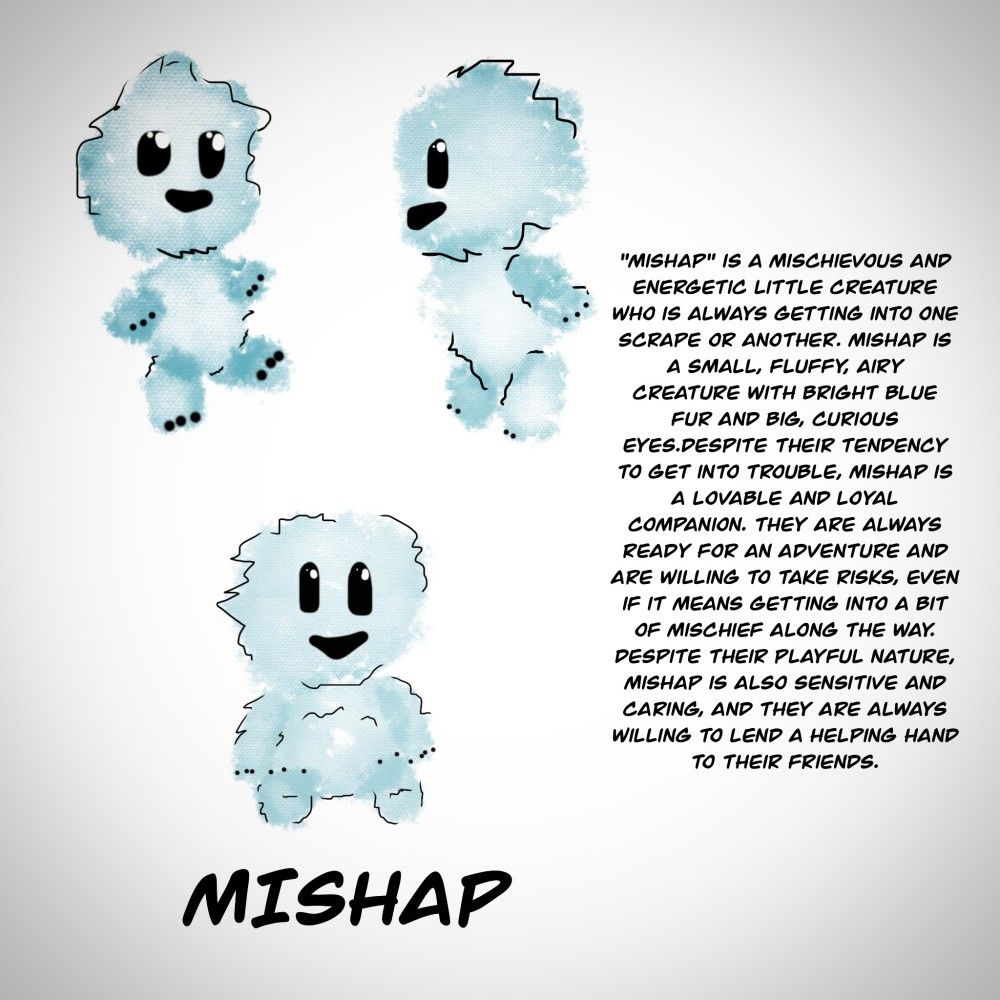Why I Created A Mental Health Character
Why I Created A Mental Health Character
Everyday I hear something in the news regarding mental health. Whether about mental health services, education, shootings, abuse, depression, anxiety. It’s everywhere.
I’m one to follow inspiration as it arises. Some may call that foolish, I call it opportunistic. When there is a need, I follow my gut and intuition to try and meet it. Now, I’m no mogul nor am I remotely wealthy enough to cause a huge impact, but when I see a way I can even impact 1 person- I’ll take it.
Why did I create a mental health character?
Creating a cartoon character like “Mishap” that revolves around mental health topics is important for our society for a number of reasons. I’ll give a few reasons why, but first who is Mishap?
"Mishap" is a mischievous and energetic little creature who is always getting into one scrape or another. Mishap is a small, fluffy, airy creature with bright blue fur and big, curious eyes.Despite their tendency to get into trouble, Mishap is a lovable and loyal companion. They are always ready for an adventure and are willing to take risks, even if it means getting into a bit of mischief along the way. Despite their playful nature, Mishap is also sensitive and caring, and they are always willing to lend a helping hand to their friends.
I started the New Year with this character in mind. Mishap is going to be experiencing a great deal of mental health difficulties this year. Stay tuned to see how Mishap works through these difficulties!
Back to the reasons.
Her are a few reasons why I developed this character:
Mental health education: By using Mishap as a platform to explore and discuss mental health topics, we can provide valuable education and information to children and adults alike. This can help to break down the stigma surrounding mental health issues and encourage people to seek help when needed.
Normalizing mental health: By portraying Mishap as a lovable, relatable character who struggles with mental health challenges, we can help to normalize these issues and show that it is okay to not feel okay all the time. This can be especially important for children, who may not yet have the language or understanding to express their own emotions.
Encouraging self-care: By showing Mishap practicing self-care and seeking help when needed, we can encourage others to do the same. This can help to prevent mental health issues from worsening and can promote overall well-being.
According to the National Institute of Mental Health, one in five children in the United States has a diagnosable mental health disorder. This statistic highlights the importance of addressing mental health in a way that is accessible and relatable to children. By using a cartoon character like Mishap, we can make these topics more approachable and encourage children to seek
Another reason why creating a cartoon character like Mishap that revolves around mental health topics is important for our society is because it can have a positive impact on children's mental health literacy and attitudes towards seeking help.
A study published in the Journal of Pediatric Psychology found that children who had access to mental health education were more likely to recognize the signs of mental health issues in themselves and others, and were more likely to seek help when needed. This is especially important given that many children do not receive proper mental health care, either due to a lack of access or a fear of stigma.
By creating a cartoon character like Mishap who openly discusses and deals with mental health issues, we can help to create a more accepting and understanding society. This can encourage more children to seek help when needed and can ultimately lead to better outcomes for their mental health.
Mishap is going to be an important step in promoting mental health awareness and understanding in our society. By providing education, normalizing mental health issues, and encouraging self-care, we can create a more supportive and accepting environment for children and adults alike.
But why?
Children often relate to fictional characters and use them as a way to make sense of the world around them. According to a study published in the journal Child Development, children often use fictional characters as "theoretical others" to try out new roles and behaviors, and to practice problem-solving and decision-making skills.
Another study published in the Journal of Research in Childhood Education found that children tend to form strong emotional bonds with fictional characters, and that these bonds can be influenced by the character's personality, appearance, and the child's own life experiences.
In addition to providing a way for children to try out new roles and behaviors, fictional characters can also serve as positive role models. According to a review published in the journal Pediatrics, children who are exposed to positive and prosocial fictional characters are more likely to exhibit prosocial behavior themselves.
Overall, the evidence suggests that children relate to fictional characters in a number of ways, including using them as theoretical others, forming emotional bonds, and taking on the characteristics and behaviors of the characters they admire.
So what prompted me specifically?
Well, I’ve been visiting Disney World since I was about 7 years old. As I get older, I find myself taking my family. It’s a magical world filled with moments of wonder and awe. It is a paradox however. Long lines, frustrated parents, overpriced everything. The experience is full of little mishaps. Especially having a 2 year old with us this year- mishaps were commonplace.
Sitting in the Walt Disney theater watching his life story inspired me to create my own fictional character! That’s how little Mishap landed in my lap. Between the spark of inspiration (and some help of Ai) I was able to turn a thought into reality.
Looking for more creative clinical content? Check out my linktree:
linktr.ee/Geries_Shaheen_LPC
Geries Shaheen is a Licensed Professional Counselor and Nationally Certified Counselor operating in and around St. Louis Missouri. Geries holds his MA in Professional Counseling from Lindenwood University, BA in Intercultural Studies from Lincoln Christian University, and holds a certificate in Life Coaching, Geries provides life coaching services to clients online globally. Geries is EMDR trained and DBT Certified, practicing from a TIC lens.

Pioneer Counseling Blog












